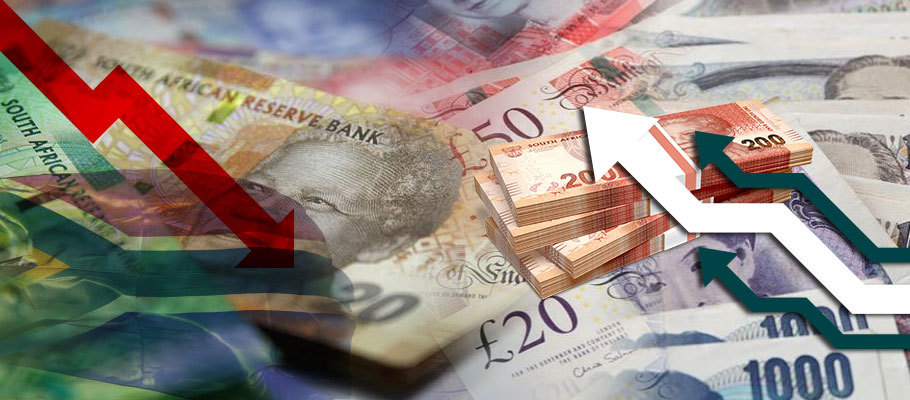
Published: July 13th, 2022
South Africa’s Rand (ZAR) is continuing a two-week run of losses against its G20 counterparts, giving a lift to GBP/ZAR as it inches toward a key level of technical resistance that risks opening the door to an even higher range in the days ahead.
ZAR tumbled during Friday’s session (8th July) as the greenback rose and both stock and commodity markets headed south after a short-lived rebound at the start of the day. Am analyst note from Nedbank said ZAR was being impacted by ‘extreme caution’ in forex markets 'as liquidity is tested and traders watch for the latest US data releases’.
USD had softened in the previous session, giving Rand and other currencies a monetary breather after falling back from a mid-week milestone driven by news that the latest US PMI figures for June were better than expected.
While the PMI numbers may have eased market worries about US recession risks, by Friday, any feelings of relief quickly gave way to anxiety about inflation indicators in June’s non-farm payrolls print. ‘A strong showing will likely mean a 75bps hike by the US Fed in July to cool down inflation worries,’ said Nedbank.
Two influential members of Fed’s rate-setting committee are on record as expressing concern about the path of American inflation expectations in forex markets. A report in The Wall Street Journal said they currently support a further 0.75 per cent interest rate hike.
Domestically, South African protests over high fuel prices and electricity rationing by the national power monopoly Eskom have disrupted South Africa’s economy by squeezing both the cost of energy and its available supply. Nedbank thinks this is least part of the reason for the previously resilient Rand’s patch of underperformance.
‘In the coming days, ten of Eskom’s shuttered generation units are expected to come back into service, which will expand power supply. Eskom will still need to ration electricity supply through loadshedding for the foreseeable future, however, until the unprecedented demand for power has stabilised’. Power market analysts are warning that more disruption is expected over the next two weeks.
Returning the generation units to operation has been delayed by civil unrest including road closures and protests around the plants where technicians and engineers need to work.
Speaking to the South African newspaper, Eskom executives said that ‘Our offices have been blockaded and staff members have been assaulted and intimidated, or in some cases even held hostage by protestors.’
Analysts have been expecting ZAR to fallback from previous highs as 2022 wears on. While Rand made a strong showing throughout the first quarter of 2022, Nedbank analysts warned in April that support could fade as Q2 wore on.
A market comment noted that ZAR had benefited from rising global commodity prices mixed with a stable domestic economy. Those two forces combined to offer global investors notable returns, but rising oil prices were expected to put Rand under pressure as energy costs rose while domestic economic growth started to fade.
‘Over the past two years, Rand has benefitted from a large trade and current account surplus. We believe that is likely to dissipate and even reverse in the coming months.’
In late May, ZAR has appreciated in value by 6.7 per cent for the year-to-date on a trade weighted basis against the currencies of its most important trading partners.
Those gains surprised some investors given that the Rand is on most forex trader lists of 'high beta' currencies that normally depreciate in times of rising geopolitical anxiety. Investors have been understandably concerned about the rolling impact of the Ukraine conflict, yet ZAR still found support thanks to South Africa’s reliance on exports of commodities and raw materials.
Nedbank wrote that the Rand was benefitting from the surge in metal prices caused by worries about supply on the back of sanctions on Russian commodity exports.
The New Zealand (NZD) and Australian (AUD) dollars have also been net beneficiaries of the current economic backdrop. Like ZAR, they tend to depreciate in times of global investor anxiety. All three are nonetheless had found support against the oil and food supply chain pressures caused by the Russian 'special operation’ in Ukraine.
Portfolio flows to Emerging Economies (EM) listed by The Institute of International Finance (IIF) for April showed that foreign investors had sold most of their emerging market positions, with the exception of South Africa, where equity markets were still seeing an inflow of outside money.
Nedbank said at the time that South Africa was giving investors looking for emerging markets exposure a combined package of relative stability when compared to Turkey, Ukraine, Russia or Brazil, plus deep financial markets and cheap market valuations.
Central bank policy has also been supportive of the Rand, with successive interest rate hikes by the South African Reserve Bank (SARB) and improving returns on assets like Rand-backed bonds.
In January, SARB had already raised the interest rate for a second time, taking it to four per cent. That didn’t stop money markets from pricing in another 200 basis points worth of increases for the rest of 2022.
Nedbank believes those expectations might be too aggressive, with a chance that many will suffer losses if fewer hikes are actually delivered.
Another ZAR downside risk Nedbank foresaw was fragility in global risk appetite. Investors were bound to adjust portfolios in response to a mix of issues that include Ukraine, inflation, supply chain bottlenecks, and rising interest rates at the Fed and elsewhere.
'The ongoing battle in Ukraine and the disruptions that Russian sanctions are creating in global commodity markets will likely increase risk-off sentiment,’ Nedbank said. ‘That muddies the outlook for global growth. The steep rate-raising path indicated by the US Fed will also test risk appetites through the remainder of 2022’.